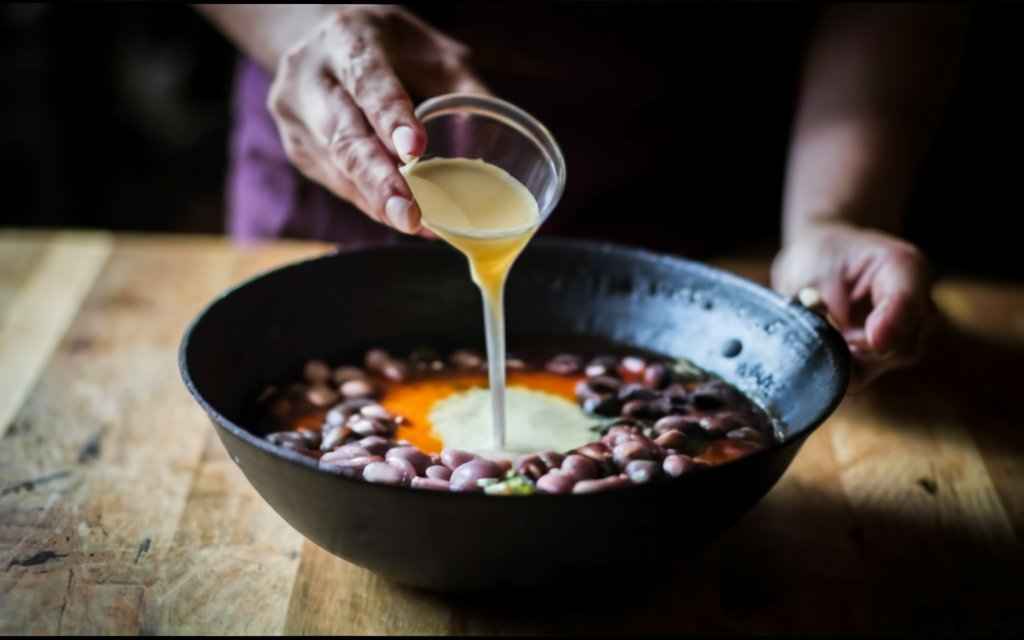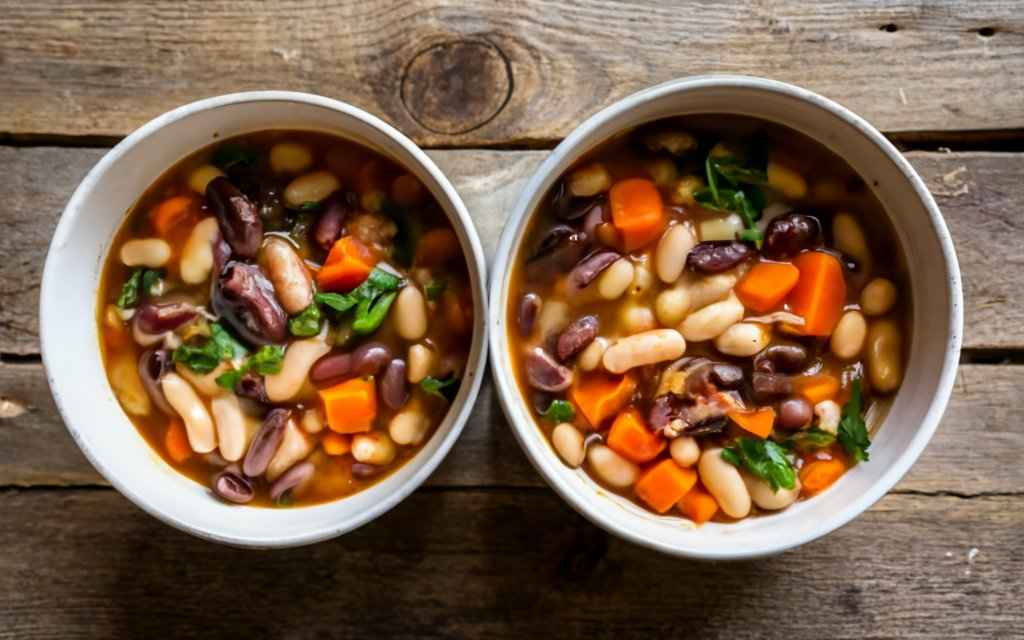Table of Contents
“Discover the secrets to thickening bean soup perfectly with natural ingredients and simple techniques for delicious results.”
“What makes bean soup thicker?”. Bean soup has a special place in the hearts of many. It’s comforting, hearty, and versatile. But let’s face it, there’s nothing worse than expecting a bowl of creamy, satisfying soup only to end up with something watery and disappointing. If you’ve ever asked yourself,
What makes bean soup thicker?, you’re not alone. Let’s dive into the art (and science) of crafting the perfect consistency for bean soup.
1.The Science Behind Thickening Soups
Before we get into the nitty-gritty, let’s understand what makes soup thick in the first place or What makes bean soup thicker?. It’s all about starches and how they interact with liquids. When starches (like those in beans, potatoes, or flour) are heated, they absorb water, swell, and create a gel-like consistency.
This process gives soups that creamy, luscious texture we all love. Without sufficient starch or structure, the soup remains thin and uninspiring. “What makes bean soup thicker?
2.Common Reasons for Thin Bean Soup
A watery bean soup isn’t the end of the world, but identifying the problem helps you fix it faster. Let’s look at a few culprits What makes bean soup thicker?:
1.Insufficient Cooking Time
Patience is a virtue when it comes to bean soup. If you rush the cooking process, the beans won’t release their natural starches, leaving your soup thin. Cooking beans longer allows them to break down, thickening the soup naturally.
2.Wrong Bean-to-Liquid Ratio
Ever feel like you added too much broth? You’re not alone. A proper balance of beans to liquid is key. Too much liquid dilutes the natural thickness that beans provide.
3.Lack of Natural Starches
Some bean varieties are naturally starchier than others. For example, black beans and kidney beans have less starch compared to cannellini or pinto beans. Choosing the right type can make a big difference. “What makes bean soup thicker?”.
3.Ingredients That Naturally Thicken Bean Soup

When it comes to thickening bean soup, nature has your back. Here are some pantry staples that can elevate your soup game
1.The Role of Beans in Creating Thickness
Beans are the star of the show, and their starches are your secret weapon. Cooking them thoroughly (or even overcooking slightly) allows their starches to seep into the broth. Blending some of the beans enhances this effect, creating a thicker, creamier base.
2.Using Potatoes or Root Vegetables
Adding diced potatoes, sweet potatoes, or even carrots can work wonders. These vegetables break down as they cook, releasing starches that blend seamlessly into the soup.
3.Incorporating Creamy Additions
Ever thought about tossing in a dollop of cream cheese, yogurt, or even coconut milk? These ingredients add body and richness to the soup while enhancing its flavor. “What makes bean soup thicker?”.
4.Techniques That Answer What Makes Bean Soup Thicker

There’s more than one way to skin a cat—or, in this case, thicken a soup. Whether you like to experiment in the kitchen or stick to tried-and-true methods, these techniques are foolproof:
1.Blending a Portion of the Soup
Grab an immersion blender or ladle some of the soup into a regular blender. Pureeing just a portion of the beans and liquid gives you a creamy consistency while maintaining texture from the whole beans.
2.Mashing Beans or Vegetables Directly
If you don’t want to dirty another kitchen tool, a potato masher works like a charm. Mash some of the beans directly in the pot to release their starches.
3.Simmering to Reduce Excess Liquid
Sometimes, the simplest solution is the best. Allow the soup to simmer uncovered for 10–15 minutes to let excess liquid evaporate. The result? A thicker, more concentrated soup. “What makes bean soup thicker?”.
5.Enhancing Thickness with Flour or Starch

If your soup is still too thin after trying natural methods, it’s time to bring out the big guns. Flour and starch-based thickeners can rescue even the most watery soups.
1.Cornstarch: A Quick Fix
Cornstarch is a go-to for thickening. Dissolve a tablespoon of cornstarch in cold water to create a slurry, then stir it into your soup. Within minutes, you’ll notice a significant change in texture.
2.Flour Slurries and Roux: Traditional Solutions
Flour slurries work similarly to cornstarch but take a little longer to cook out the raw taste. Alternatively, a roux (flour and butter cooked together) can add both thickness and a rich, nutty flavor.
3.Arrowroot or Tapioca as Gluten-Free Alternatives
For gluten-free cooks, arrowroot powder and tapioca starch are excellent options. They work just like cornstarch but don’t leave a cloudy appearance in the soup. “What makes bean soup thicker?”.
Pro Tip: Always dissolve starches in cold water before adding them to hot soup to prevent clumping.
6.Alternative Ingredients for Thickening
Want to think outside the box? These unexpected additions not only thicken your soup beautifully but also add a delightful twist to its flavor profile. Think of them as secret ingredients that take your bean soup from ordinary to extraordinary. Whether you’re aiming for a creamy texture, a nutty undertone, or a burst of richness, these creative options can surprise your taste buds in the best way possible.
Why stick to the basics when you can experiment and elevate your soup to gourmet status? Let’s explore these flavorful alternatives!
1.Nut Butters or Tahini for a Creamy Boost
Boost your soup’s texture by stirring in a spoonful of almond butter or tahini. These creamy additions add a luxurious thickness and a hint of nutty flavor. It’s an easy way to elevate your dish to gourmet status!
2.Coconut Milk or Yogurt for a Richer Texture
Coconut milk adds creaminess with a tropical twist, while yogurt offers tanginess and thickness.
3.Cheese and Dairy for Velvety Consistency
Parmesan cheese, heavy cream, or even shredded cheddar can transform your soup into a decadent delight. “What makes bean soup thicker?”.
7.Common Mistakes to Avoid When Thickening Bean Soup

Even seasoned cooks can stumble when thickening soup. From overcooking beans to using too much thickening agent, small missteps can impact texture and flavor. Let’s uncover these pitfalls and learn how to avoid them for perfect results every time!.
1.Overcooking Beans to the Point of Disintegration
While cooking beans longer helps thicken the soup, overdoing it can make your soup mushy. Aim for a balance between thickness and texture.
2.Using Too Much Thickening Agent
It’s tempting to add “just a little more,” but over-thickening can make your soup gloopy and unappetizing.
3.Ignoring Flavor Balancing During Thickening
Thickening changes not just the texture but also the flavor. Taste as you go to ensure your soup stays well-seasoned. “What makes bean soup thicker?”.
8.Troubleshooting Thin Bean Soup
Sometimes, your soup might turn out thinner than expected—but don’t worry! Quick fixes like blending, adding a thickener, or simmering longer can save the day. With a few adjustments, your bean soup will be perfectly thick and delicious!
1.Salvaging with Quick Additions
If your soup needs an immediate fix, try adding instant mashed potatoes, a handful of rice, or even bread crumbs. These ingredients absorb liquid quickly and add body.
2.Balancing Flavor While Thickening
If your soup becomes too thick while fixing it, thin it out with a little broth or water. Don’t forget to adjust the seasoning! “What makes bean soup thicker?”.
9.Tips for Perfectly Thickened Bean Soup
Want to get it right every time? Focus on cooking beans slowly, using the right tools like an immersion blender, and balancing your liquid-to-bean ratio. With these tips, your soup will always turn out perfectly thick and satisfying!
1.Best Cooking Practices
For the best results, cook your beans slowly over low heat. This method allows the starches to release gradually, creating a naturally thick and creamy texture. Take your time—good soup is worth the wait! “What makes bean soup thicker?”.
2.Ideal Tools for Achieving Desired Consistency
An immersion blender is your best friend for on-the-spot thickening. A potato masher also gets the job done without fancy gadgets.
3.How to Test Thickness Before Serving
To check your soup’s consistency, use the spoon test! Dip a spoon into the soup—if it coats the back without dripping off, you’ve nailed it. This simple trick ensures your soup is perfectly thick and ready to serve! “What makes bean soup thicker?”.
10.Nutrition Facts for Bean Soup (Approximate Per Serving)
| Nutrient | Amount |
|---|---|
| Calories | 200-250 |
| Protein | 12-15g |
| Carbohydrates | 30-35g |
| Fat | 2-4g |
| Fiber | 8-10g |
| Sodium | 400-600mg |
11.FAQs About What Makes Bean Soup Thicker
When it comes to perfecting bean soup, questions often pop up. Let’s tackle some of the most common ones to help you become a soup master. “What makes bean soup thicker?”.
1.Why does my bean soup have no flavor?
If your bean soup lacks flavor, it’s often due to under-seasoning or skipping aromatics like garlic, onions, and herbs. Beans absorb flavors slowly, so add spices early and taste as you go read more… A splash of vinegar or squeeze of lemon can also brighten the taste!
2.Can I Fix Thin Bean Soup Without Starting Over?
Absolutely! You can fix thin bean soup without starting from scratch. Try blending a portion of the soup, adding a quick thickening agent like cornstarch, or incorporating instant mashed potatoes. These quick fixes work wonders and can save the day. “What makes bean soup thicker?”.
3.What Are the Best Beans for Thick Soups?
Beans like navy beans, pinto beans, and cannellini beans are excellent for thick soups. Their higher starch content helps naturally thicken the broth as they cook. Black beans and kidney beans, while flavorful, are less effective at creating a thick texture on their own.
4.How Do I Prevent Bean Soup From Becoming Too Thick?
It’s all about balance. Keep an eye on the liquid-to-bean ratio, and avoid overcooking the beans to the point of disintegration. If your soup does become too thick, thinning it out with a bit of broth or water can restore the perfect consistency. “What makes bean soup thicker?”.
5.Can I Use Frozen Beans or Vegetables in Bean Soup?
Yes, frozen beans or vegetables can work, but they may release extra water as they cook. Adjust your liquid accordingly, and consider simmering the soup longer to reduce any excess water.
6.Does the Type of Pot Affect Soup Thickness?
Surprisingly, yes! Using a heavy-bottomed pot like a Dutch oven ensures even heat distribution, which helps beans cook more uniformly and release their starches effectively. Thin pots can lead to uneven cooking and a thinner soup. “What makes bean soup thicker?”.
12.Mastering the Art of Perfect Bean Soup
“What makes bean soup thicker?”. There you have it—the ultimate guide to thickening bean soup! Whether you’re relying on the natural starches of beans, blending for creaminess, or using creative thickening agents, the possibilities are endless. Thickening soup is as much an art as it is a science, and with practice, you’ll find the method that works best for your tastes and needs.bean soup thicker.
Remember, great soup takes time and care. So the next time you’re standing over your pot, don’t stress. Experiment, have fun, and enjoy the process of creating a comforting bowl of perfection. “What makes bean soup thicker?

